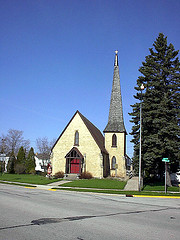St Agnes-by-the-Lake Episcopal Church (Algoma, Wisconsin)
| St. Agnes-by-the-Lake Episcopal Church | |
|---|---|
 | |
| Religion | |
| Affiliation | Episcopal, Anglican |
| District | Diocese of Fond du Lac |
| Province | Province V |
| Leadership | The Rev'd Robert Hoppe, SSC, Vicar |
| Year consecrated | 1891 (current building) |
| Location | |
| Location | Algoma, Wisconsin, USA |
| Architecture | |
| Architect(s) | Richard Upjohn |
| Type | High-Church Anglican |
| Style | neo-gothic |
| Completed | 1891 (current building) |
| Specifications | |
| Direction of façade | reverse east-west |
| Capacity | 100 |
| Materials | timber frame with 'cream city' brick veneer |
| Website | |
| St. Agnes Episcopal Church | |
St. Agnes-by-the-Lake Episcopal Church, Algoma, Wisconsin, (originally called Grace Church) United States, is an Anglo-Catholic mission congregation of the Episcopal Diocese of Fond du Lac. The congregation first met in 1877, becoming an organized mission in 1897.
History
The first church service in Ahnapee, the former name of Algoma, was held by the Rt. Rev'd John Henry Hobart Brown, Bishop of Fond du Lac, on Aug. 15, 1877, one person being confirmed, and an infant baptized. The first building, named “Grace Church”, was built in 1878 according to a design by Richard Upjohn (architect of New York City’s famous Trinity Church, Wall Street, and founder of the American Institute of Architects). This was the first edifice to be constructed in the diocese following its organization in 1875.
Grace Church burned to the ground in the spring of 1884. It was not until 1891 that the parishioners, with the encouragement and financial support of the second Bishop of Fond du Lac, the Rt. Rev'd Charles Chapman Grafton, could rebuild their church. The new edifice, reconsecrated as “St. Agnes-by-the-Lake”, was built on the old foundation and is an exact replica of the original Upjohn design. This new structure was also the first church to be built during Bp. Grafton’s episcopate. A separate parish house, comprising a guild hall and vicar's residence, was completed two years later.
The arrival in 1897 of the Rev’d Dr. W.R. Gardner, SSJE, sometime dean (president) of Nashotah House Seminary, marked the beginning of Anglo-Catholic liturgical practice at St. Agnes. It is during his tenure that "High Mass", including use of incense and other sacramental symbolism, became normative Sunday practice. It is also during this time that the present altar and carved wood statuary were installed. The figures on the rood beam (Jesus, St. Mary, and St. John) were carved by artists from Oberamergau, Germany, who were brought over to Wisconsin by Bp. Grafton to do extensive carving for St. Paul's Cathedral, Fond du Lac. During this time, several additional rood groupings were carved, one of which was presented to St. Agnes Church.
After Dr. Gardner’s death in late 1906, the Rev'd H.W. Blackman became the next resident vicar. As a result of Fr. Blackman’s 33-year tenure, the churchmanship introduced by Dr. Gardner continued to flourish, and was further heightened and secured by the introduction of the Anglican Missal (i.e., American-SSJE). Bishop Grafton, Dr. Gardner, and Fr. Blackman, prior to their residencies in Wisconsin, were all affiliated with Boston’s Church of the Advent, the mother church of the Anglo-Catholic movement in America.
Highlights
- Dr. Gardner, Fr. Blackman and Bishop Grafton, prior to their residencies in Wisconsin, were affiliated with Boston's Church of the Advent, the mother church of the Anglo-Catholic movement in America.
- The building has received landmark status from the Kewaunee County Historical Society.
- The connection to the community is strong, through supporting and hosting such agencies as Friends of the Library and the Food Pantry.
- The Faith and Arts Outreach program brings a diversity of artists to for concerts and exhibits which benefit local not-for-profit organizations.
- After developing plans for gardens on the church property, a modern sculpture rendition by Norbertine Father Donald Claude Noel of the Archangel Michael depicted as calming the stormy sea was dedicated in 2009
- There is a prevailing legend that, before the current Algoma lighthouse was completed in 1893, the steeple of this church served, in some way, as a navigational guide for ships on Lake Michigan.
Clergy Serving
This is listing of clergy who have served as missionaries, vicars or deacons.
- 1878-1883 Francis Moore
- 1883-1884 C.D. Mack
- 1884-1887 W. R. Gardner
- 1887-1888 E.R. Sweetland
- 1889-1892 Joseph Jameson
- 1892-1896 A.P. Curtis
- 1896 H. W. Blackman
- 1896-1897 John Sword
- 1897-1906 W. R. Gardner
- 1906-1907 H. S. Dawson
- 1907-1940 H. W. Blackman
- 1940-1941 W.S. Booker (Deacon)
- 1941-1942 B.F. Miller & H.M. Keyes
- 1943-1944 Ira A. England
- 1944-1946 B.F. Miller & H.M. Keyes
- 1946-1949 C.A.G. Heiligstedt
- 1949-1955 James Pearson & William Carpenter
- 1956-1960 R.E. Blackburn, Jr.
- 1960-1978 Roy A. F. McDaniel
- 1979-1981 John Schumacher
- 1981-1986 Robert F. Stub
- 1989–Present Robert D. Hoppe
References
Curtiss, A. Parker (1925). History of the Diocese of Fond du Lac and Its Several Congregations. Fond du Lac, Wisconsin: P.B. Haber Printing. Compiled Under The Direction of The Bishop, in Commemoration of its FIFTIETH ANNIVERSARY
Evans, Ruth (1977). The History of St. Agnes by the Lake Episcopal Church, Algoma, Wisconsin. Algoma, Wisconsin. p. 8. (N.B.-Mrs. Evans' history of this congregation is largely anecdotal.)
{{cite book}}: CS1 maint: location missing publisher (link)
"Archangel Michael statue dedication planned at St. Agnes" (PDF). The Clarion of the Diocese of Fond du Lac. September 2009.
External links
- Official Website of the Diocese of Fond du Lac
- History of the Diocese of Fond du Lac and Its Several Congregations 1925 diocesan history
- [1] St. Michael Statue Dedication (Norbertine website)
- St. Agnes-by-the-Lake Episcopal Church
